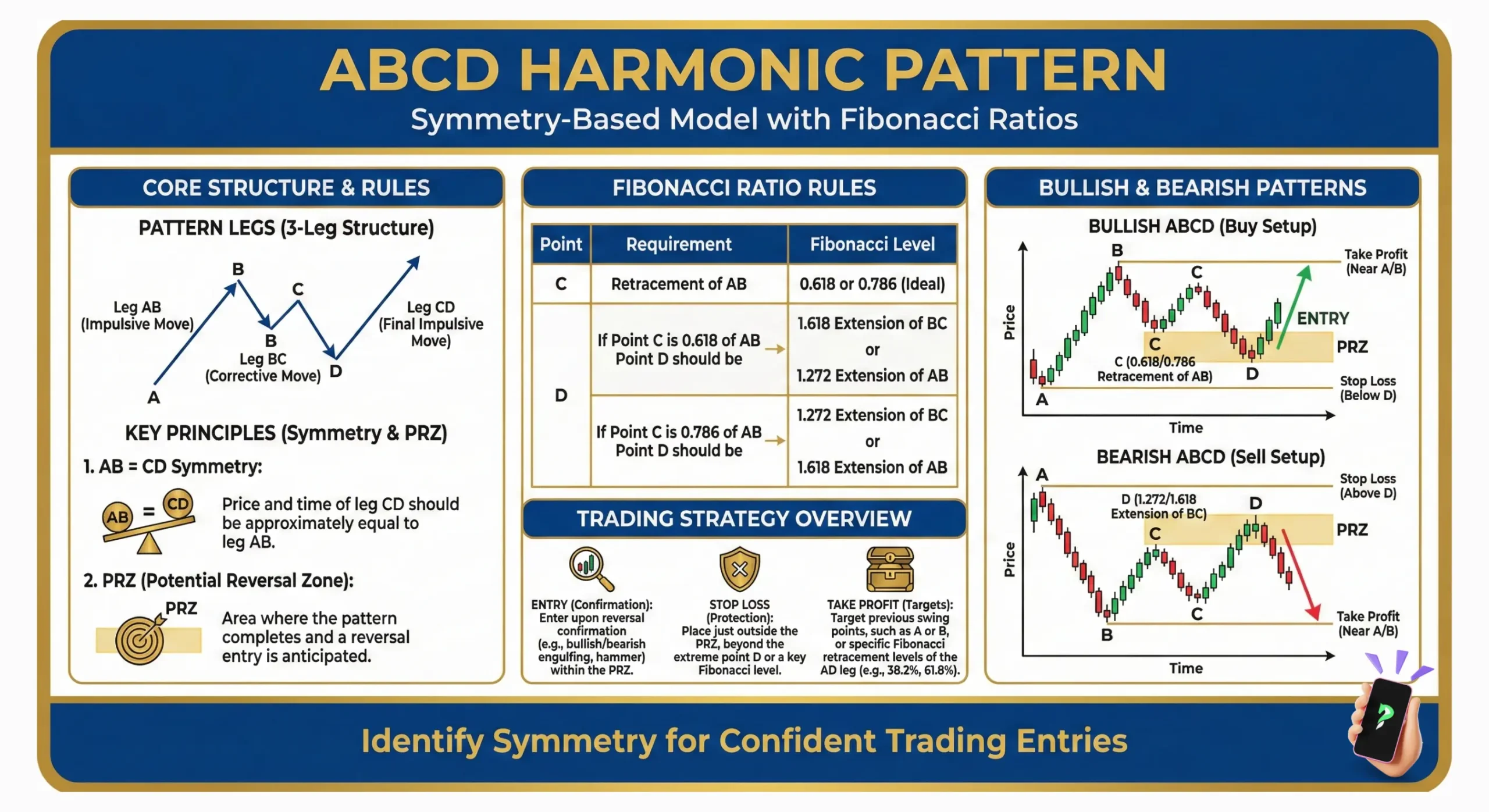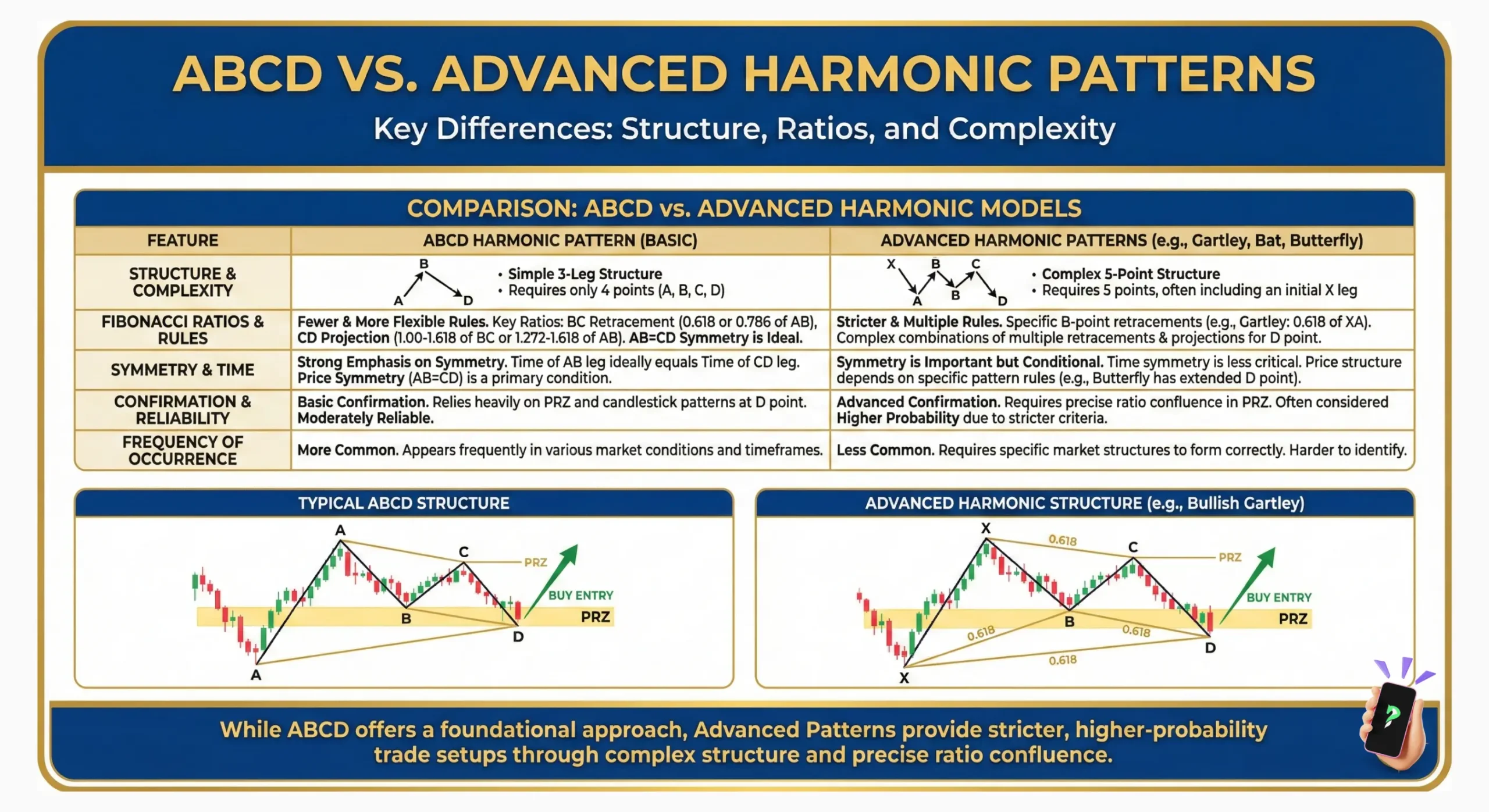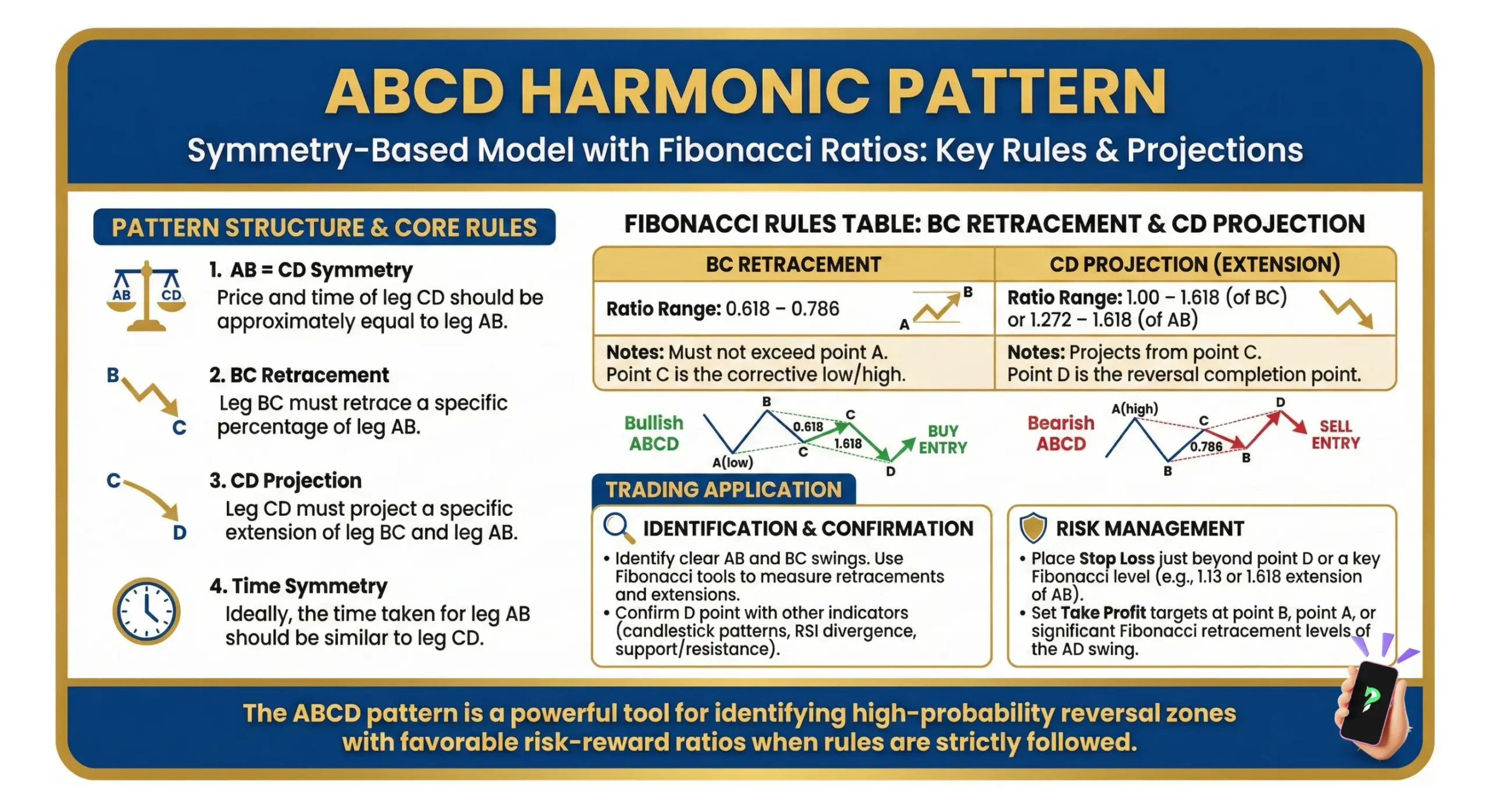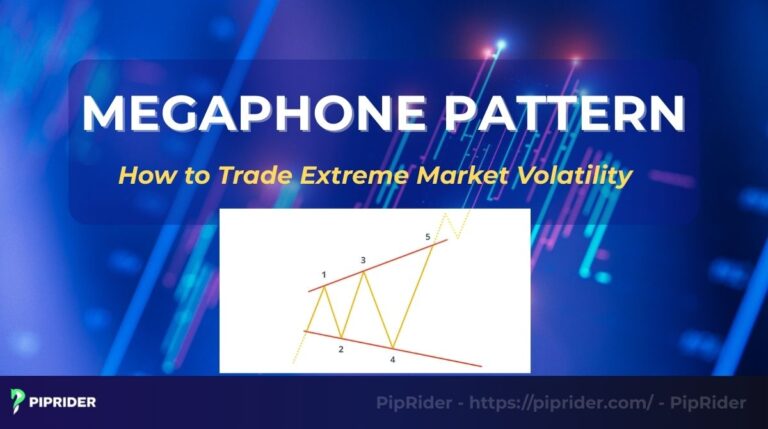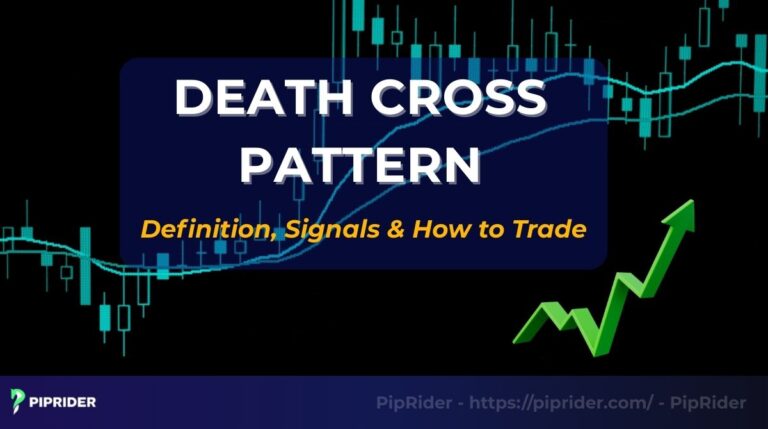The ABCD harmonic pattern is the fundamental building block of all harmonic formations. It’s a high-probability predictive tool based on Fibonacci ratios and market symmetry, crucial for any serious trader. This price pattern provides a geometrically precise roadmap for entry and exit. Mastering this structure is essential for successful trading ABCD pattern strategies across forex, crypto, and stocks.
This guide reveals the rigid rules of the ABCD pattern, details how its legs (AB, BC, CD) define the trade, and provides the proven strategies you need.
Key Takeaways
- The ABCD harmonic pattern is the most basic structure, defined by symmetry where the AB leg must equal the CD leg.
- Confirmed by strict Fibonacci ratios: BC retraces AB, and CD projects from those retracements.
- Trade execution occurs only at point D (the Potential Reversal Zone), signaling the sharp reversal.
- Accuracy is boosted when point D is validated by RSI divergence or major support/resistance levels.
- Precisely anticipate the sharp reversal at point D to execute high-probability trades.
1. What Is the ABCD Harmonic Pattern?
The ABCD harmonic pattern is a specific price pattern consisting of three consecutive, symmetrical price swings (Definedge Securities, n.d.).
It signals an imminent trend reversal after the completion of the final swing, giving traders a high-confidence entry point.

It’s composed of three segments: two impulse “legs” (AB and CD) and one correctional “retracement” leg (BC). The legs AB and CD tend to be approximately the same size, aiming for symmetry (FXOpen UK, n.d.).
Other harmonic patterns (like the Gartley, Bat, or Butterfly patterns) are fundamentally derived from the principles of the ABCD pattern. Its core principle is market symmetry, governed by Fibonacci ratios, making it the essential foundation for complex harmonic analysis.
Recognizing the ABCD pattern is vital because it establishes a precise Potential Reversal Zone (PRZ) at point D. This clarity minimizes subjective interpretation, allowing traders to set ultra-specific risk parameters for trading the ABCD pattern, a massive advantage in technical analysis.
2. How the ABCD Pattern Forms
The formation of the ABCD harmonic pattern is strictly governed by symmetry and specific Fibonacci ratios. Understanding the geometric relationship between the four pivot points (A-B-C-D) is non-negotiable for proper execution.
2.1. Structure with Points A–B–C–D
The ABCD pattern is built from three distinct, alternating price swings:
- Leg AB (The Initial Impulse): This move establishes the initial trend direction, whether bullish (move up) or bearish (move down).
- Leg BC (The Retracement): The correction phase moves against the direction of Leg AB. Point C is the first critical validation point, determined by a Fibonacci retracement of the AB leg.
- Leg CD (The Final Impulse): The final, price-action move completes the pattern. It moves in the same direction as AB and leads to Point D, the target Potential Reversal Zone (PRZ) where the trade is executed.
2.2. Fibonacci Ratios for Validation
The integrity of the ABCD harmonic pattern relies entirely on the precise alignment of Fibonacci ratios. Failure to meet these internal rules invalidates the setup, regardless of how the pattern “looks” visually.
| Relationship | Ratio Requirement | Purpose |
| BC Retracement of AB | BC must retrace AB between 0.618 and 0.786. | Validates that Point C is a shallow, healthy correction, not the start of a new trend. |
| CD Projection | CD is typically an extension of AB (1.00 to 1.618) or an extension of BC (1.272 or 1.618). | Establishes the exact location of Point D (PRZ) where the price is expected to reverse. |
| Price Symmetry | The price length of Leg AB must be equal to the price length of Leg CD | This is the hallmark of the classic ABCD pattern, confirming symmetrical momentum. |
2.3. Time Symmetry (AB ≈ CD in Duration)
Advanced traders look beyond just price for confirmation, incorporating time analysis. True symmetry is achieved when the time it takes for price to move from A to B is approximately equal to the time it takes for price to move from C to D (AB in time ≈ CD in time). This time alignment further boosts the accuracy of Point D as a significant reversal zone.
Read more:
Crab Pattern In Trading: Definition, Strategy, And Examples
3. ABCD Pattern Rules
The ABCD harmonic pattern is defined by a set of rigid, non-negotiable Fibonacci ratios. To execute a high-probability trade, traders must confirm the pattern adheres to these specific geometric laws (Investopedia, 2024).
3.1. Minimum and Maximum Retracement Levels
The integrity of the ABCD pattern starts with Leg BC, which must meet a specific retracement requirement relative to Leg AB.
- Rule: Leg BC must retrace Leg AB between the 0.618 and 0.786 Fibonacci levels.
- Invalidation: If Point C exceeds the price of Point A (retracing more than 1.00), the pattern is immediately invalidated. Excessive retracement (e.g., beyond 0.886) also severely weakens the setup.
3.2. Extension Ratios for CD Leg
The final leg, CD, is projected using Fibonacci extension tools to pinpoint the PRZ at Point D.
- Symmetry Rule (AB = CD): The classic ABCD harmonic pattern requires the price distance of Leg CD to be 1.00 times the distance of Leg AB.
- Projection Rule: The most reliable signals occur when this AB=CD symmetry converges with a BC extension of 1.272 or 1.618 times the length of BC.
- PRZ Strength: The tighter the convergence of these ratios at Point D, the stronger the anticipated reversal.
3.3. Entry and Exit Confirmation Signals
Never trade the PRZ at Point D in isolation. Confirmation is vital to filter out false signals and manage risk.
- Momentum/Divergence: Look for RSI or MACD divergence at Point D. This confirms seller/buyer exhaustion and strengthens the reversal thesis.
- Price Action: Wait for a clear reversal candlestick pattern (e.g., Engulfing pattern or Pin Bar) to form at Point D, confirming aggressive counter-directional entry.
- Volume: An ideal entry involves a sharp increase in trading volume coinciding with the reversal candlestick, validating institutional participation.
4. Bullish ABCD Pattern
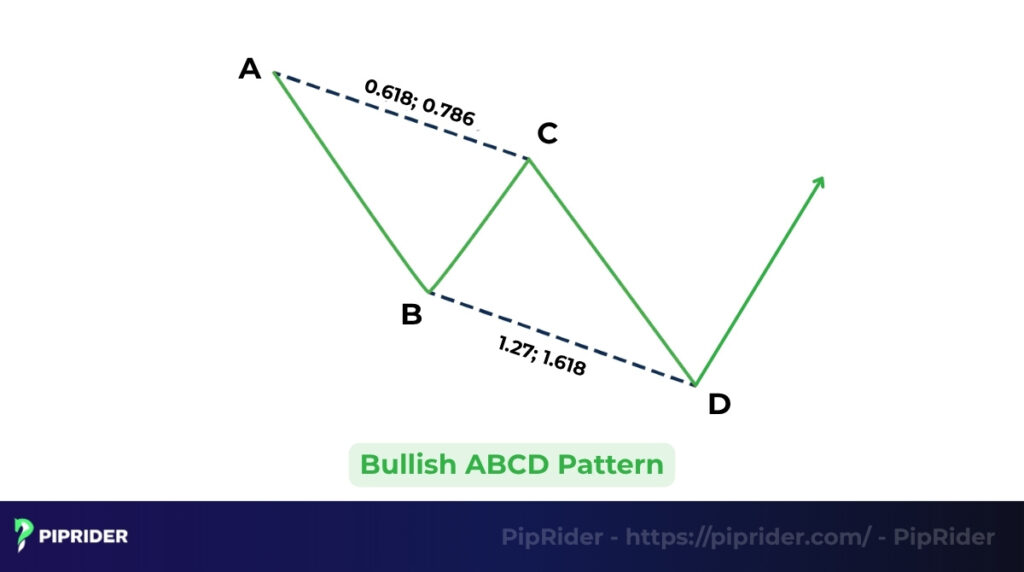
This pattern signals a strong potential reversal from a downtrend to an uptrend, providing a low-risk opportunity to initiate a Long (Buy) position at Point D.
The Bullish setup is completed by a price move that moves downward overall, but finishes its symmetrical structure at a low point (D). Traders prepare to Buy (Go Long) at Point D (the PRZ), anticipating a sharp reversal upward.
The setup is valid only if Point C retraces AB between 0.618 and 0.786. The Long entry is executed where the final leg CD converges with the 1.00 extension of AB (classic symmetry) and the 1.272 or 1.618 extension of BC.
Example: If a forex pair drops 100 pips (A to B) and retraces to 0.618 (Point C), the trader projects the final 100-pip drop to identify Point D. Once a reversal candlestick pattern confirms the PRZ at D, the Long position is executed.
5. Bearish ABCD Pattern
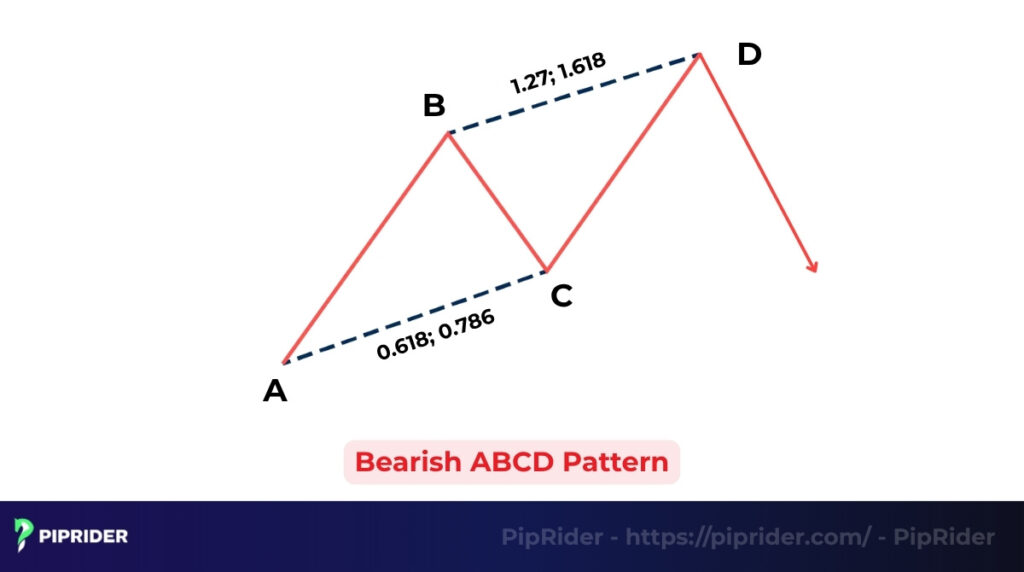
This pattern signals a strong potential reversal from an uptrend to a downtrend, providing a high-probability opportunity to initiate a Short (Sell) position at Point D.
The Bearish setup is completed by a price move that moves upward overall, but finishes its symmetrical structure at a high point (D). Traders prepare to Sell (Go Short) at Point D (the PRZ), anticipating a sharp reversal downward at a level that often coincides with major resistance.
The setup is valid only if Point C retraces AB between 0.618 and 0.786. The Short entry is executed where the final leg CD converges with the 1.00 extension of AB (classic symmetry) and the 1.272 or 1.618 extension of BC.
Example: If a stocks chart rallies 20 points (A to B) and retraces to the 0.786 level (Point C), the trader projects the final 20-point rally to identify Point D. Once a reversal candlestick pattern (e.g., a Shooting Star) confirms the PRZ at D, the Short position is executed.
6. Example of ABCD Pattern on a Chart
This is a practical, step-by-step walkthrough of identifying and trading a validated ABCD harmonic pattern (suitable for forex, crypto, or stocks).
Step-by-Step Walkthrough (Setup):
- Identify AB & Validate C: On a USD/JPY (Forex) chart, the price drops from A (145.00) to B (144.00) (Leg AB = 100 pips). The price then corrects upward to C (144.382). Point C is valid as it’s a 0.618 retracement of AB (Chen, 2024).
- Confirm D (PRZ): Use the Fibonacci Extension tool. Point D is projected at the 1.00 extension of AB from C, resulting in a target price of 143.382. This tight zone is the PRZ.
Trading Outcome (Scenario):
- Execution: Price hits the PRZ at Point D (143.382). The trader observes strong RSI divergence (momentum confirmation) and a large Hammer candlestick pattern forms. A Long (Buy) position is executed immediately.
- Risk: The Stop Loss is placed tightly just below the hammer’s low, at 143.300.
- Result: The price reverses sharply from Point D, climbing back toward Point C (Take Profit 1) and Point A (Take Profit 2), validating the pattern symmetry and resulting in a high-probability trade.
7. Trading with the ABCD Pattern
Successful execution of the ABCD harmonic pattern requires discipline at the PRZ, Point D. The strategy focuses on maximizing the inherent low-risk, high-reward nature of this symmetrical price pattern. By defining rules for entry, stop loss, and profit targets, traders can convert the pattern’s predictive symmetry into concrete trading actions.
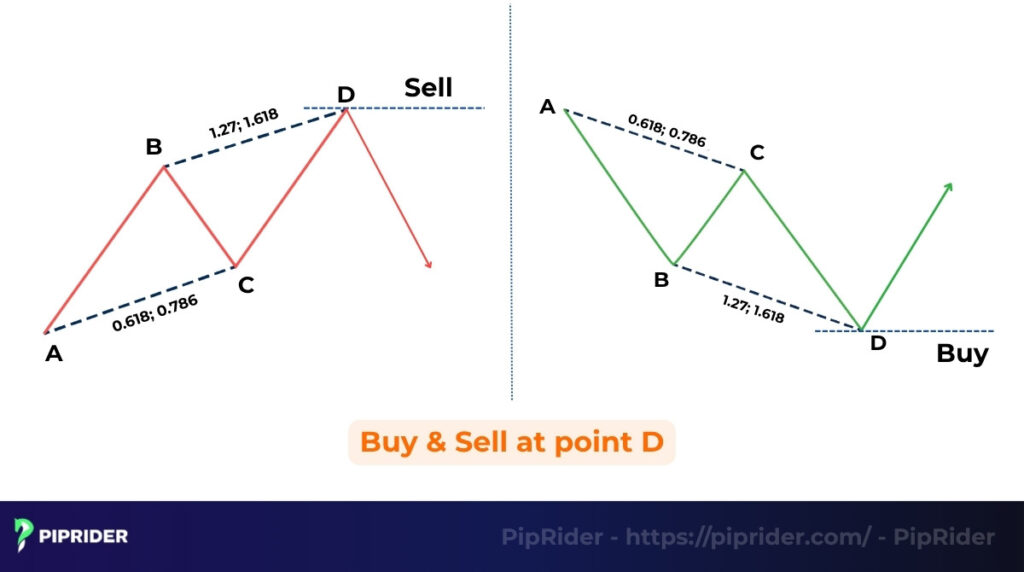
7.1. Entry Rules at Point D
Effective entry management is crucial, as the failure rate is high if traders rush into the trade before reversal confirmation. The following rules minimize risk at the critical Point D:
- Confirmed Entry: Never place a limit order directly at the projected Point D. Initiate a Long (Buy) or Short (Sell) order only after a definitive reversal candlestick pattern (e.g., Engulfing, Hammer) closes, confirming the reversal is active.
- Momentum: An aggressive entry can be made once a clear break of the reversal candlestick’s high/low occurs, ideally supported by RSI divergence.
7.2. Stop-Loss Placement (Below/Above D)
The precise placement of the Stop-Loss is the primary determinant of the trade’s risk profile. The structure of the ABCD pattern allows for an extremely tight SL, enhancing the risk/reward ratio:
- Tight Placement: The primary advantage of trading the ABCD pattern is the ability to place a very tight Stop-Loss (SL).
- Location: The SL must be placed marginally below Point D for a Bullish setup, or marginally above Point D for a Bearish setup. If price moves past Point D significantly, the entire harmonic pattern structure is invalidated.
7.3. Take-Profit Targets (Point C or Fibonacci Extension)
Setting logical Take-Profit (TP) targets is essential for locking in profits and managing the position. Targets are generally derived from prior high/low points within the pattern structure:
- TP1 (Conservative): Set the first target at the level of Point C. This is the highest probability target, as price often quickly revisits the last correction level.
- TP2 (Aggressive): Set the second target at the level of Point A or a Fibonacci extension of the CD leg (e.g., 1.272 or 1.618 of CD, projected from D).
7.4. Risk/Reward Examples
Due to the tight Stop Loss placement and clearly defined targets, the ABCD pattern is known for its superior risk management profile:
- The tight Stop Loss at Point D relative to the Take Profit levels often yields an excellent Risk-to-Reward Ratio (RRR), typically 1:2 or higher.
- This favorable RRR is what makes the ABCD harmonic pattern a preferred low-risk setup for professional traders.
8. Advantages and Limitations of the ABCD Pattern
Understanding the strengths and weaknesses of the ABCD pattern is essential for effective risk management in harmonic trading. The decision to execute a trade must weigh its predictive clarity against its inherent risks.
8.1. Advantages (Strengths)
The ABCD pattern is highly valued by traders as the foundation of harmonic analysis due to its mechanical clarity and superior risk management characteristics:
- Objective rules: Defined by strict Fibonacci ratios (0.618, 1.00), offering clear and objective rules and minimizing subjective interpretation.
- Ease of use: The symmetrical AB=CD structure is simple to spot, making it easy to learn and identify for new harmonic traders.
- Universal application: Based on universal market symmetry, the pattern works across all markets (forex, stocks, crypto) and time frames.
- Superior Risk/Reward: Allows for an extremely tight Stop Loss placement at Point D, creating a highly favorable Risk/Reward Profile.
8.2. Limitations (Weaknesses)
Despite its clarity, the strict geometric requirements of the pattern introduce certain limitations that traders must actively manage:
- Rarity: The perfect alignment of all required time and price Fibonacci ratios means the ideal ABCD pattern can be rare.
- False signals: The pattern is prone to false signals if traders ignore confirmation. Entry at Point D without supporting evidence (like RSI divergence or a reversal candlestick pattern) leads to high failure rates.
- Discipline required: Requires high patience to wait for the full completion of the CD leg and the final reversal confirmation before trading.
9. Common Mistakes When Trading the ABCD Pattern
While the ABCD harmonic pattern offers clear rules, human error and impatience are the biggest threats to profitability. Traders must be aware of common pitfalls that can turn a high-probability setup into a losing trade (Finance Strategists, n.d.).
- Entering too early before D is confirmed: This is the most critical mistake. Anticipating the move and entering before the CD leg fully completes is a common error. Doing this, or entering before a definitive candlestick pattern forms at the PRZ (Point D), inevitably leads to being stopped out as the final leg extends further than expected.
- Ignoring Fibonacci ratio alignment: Blindly identifying four swing points (A-B-C-D) without confirming the precise geometric structure is fatal. The pattern is invalidated if the BC leg does not meet the strict 0.618-0.786 retracement requirement, or if the AB=CD symmetry is broken.
- Overtrading in sideways markets: The ABCD pattern is a reversal signal that performs best when preceded by a clear, sustained directional move. Attempting to trade the pattern during prolonged consolidation or choppy market conditions often generates noise and produces unreliable reversal signals, wasting capital.
10. ABCD Pattern vs Other Harmonic Patterns
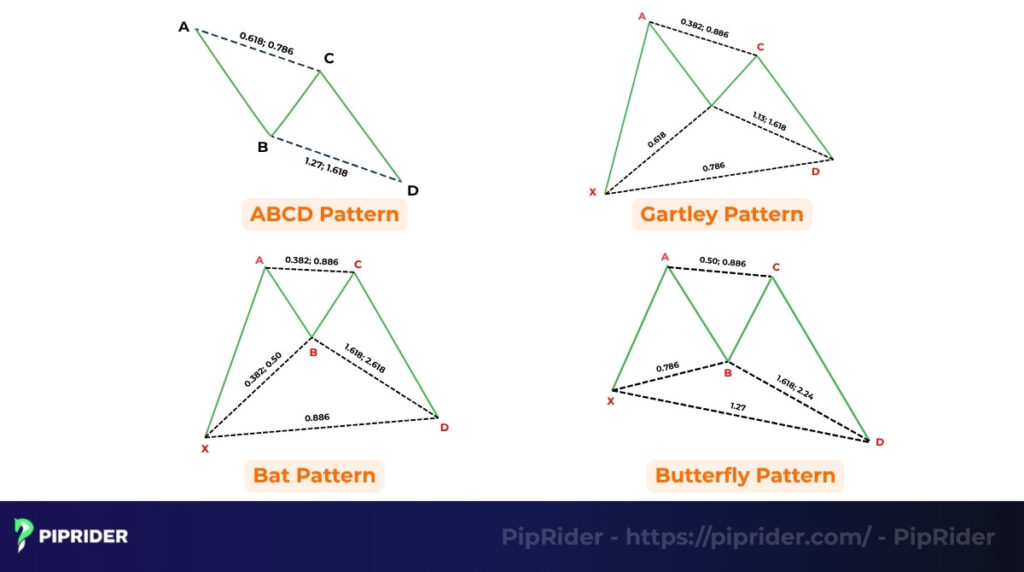
While the ABCD Pattern is the foundation, the Gartley, Bat, and Butterfly patterns all expand this concept by adding an initial leg (XA leg) and imposing stricter Fibonacci ratios (Definedge Securities, n.d.).
| Feature | ABCD Pattern (Foundation) | Gartley Pattern | Bat & Butterfly Patterns |
| Number of Points | 4 points: A-B-C-D | 5 points: X-A-B-C-D | 5 points: X-A-B-C-D |
| Core Relationship | AB wave must equal CD wave | The ABCD wave must be integrated within the larger XA wave. | Similar to Gartley, but utilizing shallower (Bat) or deeper (Butterfly) extension/retracement ratios. |
| B Ratio (of XA) | Not applicable (No XA leg). | Point B must be a 0.618 retracement of XA. | Bat: B <0.618 (typically 0.382 or 0.50). Butterfly: B <0.786. |
| D Ratio (PRZ) | Point D is determined by AB=CD and the 1.272/1.618 extension of BC. | Point D must be a 0.786 retracement of XA. | Bat: D is 0.886 retracement of XA. Butterfly: D is 1.272 or 1.618 extension of XA. |
| Complexity | Easiest to identify and trade; based only on symmetry. | More complex, requiring two sets of Fibonacci rules to converge at D simultaneously. | Most complex, usually signaling reversals at extreme zones (Bat close to X, Butterfly beyond X). |
11. Frequently asked questions about ABCD Harmonic Pattern
12. Conclusion
The ABCD harmonic pattern is the fundamental framework for all advanced harmonic trading. Its power lies in its perfect symmetry and non-negotiable Fibonacci ratios (Chen, 2024).
The success of the ABCD pattern is intrinsically linked to Fibonacci ratios. These precise ratios (0.618, 0.786, 1.00) convert a visual guess into a mathematical probability. Strict adherence to these levels ensures you are trading high-quality structures, filtering out noise.
Once you’ve mastered the foundational ABCD pattern and its entry rules, advance your expertise by exploring its derivatives: the Gartley, Bat, and Butterfly patterns. These structures embed the core AB=CD principle within a larger context, offering even higher-probability setups for experienced traders.
Ready to find your next setup? Explore more high-probability trading strategies at Piprider‘s comprehensive Analysis section today!



